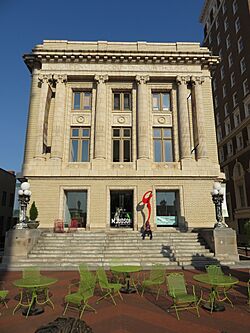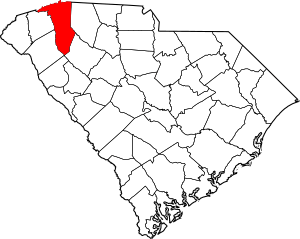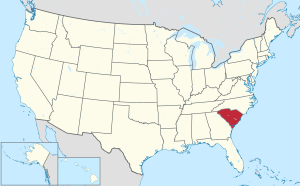Greenville County, South Carolina facts for kids
Quick facts for kids
Greenville County
|
|||
|---|---|---|---|

Old Greenville County Courthouse
|
|||
|
|||
| Motto(s):
"Unrivaled Quality Of Life"
|
|||

Location within the U.S. state of South Carolina
|
|||
 South Carolina's location within the U.S. |
|||
| Country | |||
| State | |||
| Founded | 1786 | ||
| Named for | Nathanael Greene | ||
| Seat | Greenville | ||
| Largest community | Greenville | ||
| Area | |||
| • Total | 795.57 sq mi (2,060.5 km2) | ||
| • Land | 785.93 sq mi (2,035.5 km2) | ||
| • Water | 9.64 sq mi (25.0 km2) 1.21% | ||
| Population
(2020)
|
|||
| • Total | 525,534 | ||
| • Estimate
(2023)
|
558,036 |
||
| • Density | 660.575/sq mi (255.0496/km2) | ||
| Time zone | UTC−5 (Eastern) | ||
| • Summer (DST) | UTC−4 (EDT) | ||
| Congressional districts | 3rd, 4th | ||
Greenville County is a busy and growing area in the U.S. state of South Carolina. It's often called "Upstate South Carolina." In 2020, over 525,000 people lived here, making it the most populated county in the state.
The main city and county seat is Greenville. This county is also home to the Greenville County School District, which is the biggest school system in South Carolina. Greenville County is a central part of a larger metropolitan area that includes nearby cities like Anderson and Greer.
Contents
History of Greenville County
Early Years: 1700s and 1800s
Greenville County was created in 1786. It was named after General Nathanael Greene, a hero from the American Revolution. Back then, it was part of a larger area called Ninety-Six District.
After the American Civil War in the 1860s, big changes happened. Slavery ended, and many former slaves gained their freedom. The textile industry, which makes cloth and fabric, started to grow very fast. Cotton farming also became more popular. In 1893, the Southern Railway was completed. This train line connected Greenville County's economy to the rest of the country.
The 1900s and Modern Growth
In the early 1900s, more railroads helped connect the county to the national economy. Many textile companies opened, and people who worked on farms moved to live in the "mill villages" near these factories.
During World War I (1914-1918), Camp Sevier was built in Taylors, South Carolina. This military camp brought more people and connections to the county. A famous food company, Duke's Mayonnaise, started in Greenville in 1917 and still has its main office here.
World War II (1939-1945) brought even more work for the textile industry. After the war, farming became less important. Local leaders looked for new industries to replace textiles. In the 1960s, Donaldson Air Force Base became an industrial park, and the Greenville–Spartanburg International Airport opened. These changes helped the county grow and connect with the world.
The 1960s also saw important social changes. Schools in the county gradually became integrated, meaning students of all races could attend together. By January 1970, the entire school district was integrated. New interstate highways like I-85, I-185, and I-385 were built. These roads made travel and trade easier, helping the economy grow even more.
Geography of Greenville County
Greenville County covers about 795 square miles. Most of this area is land, with a small part being water.
Nature and Parks
Greenville County has many beautiful natural areas and parks. These places help protect wildlife and offer fun outdoor activities. Some popular spots include:
- Caesars Head State Park
- Conestee Nature Preserve
- Falls Park on the Reedy
- Greenville Zoo
- Jones Gap State Park
- Paris Mountain State Park
Rivers and Lakes
Important rivers and water bodies in the county include:
- Enoree River
- North Saluda Reservoir
- Reedy River
- Saluda River
Neighboring Counties
Greenville County shares its borders with several other counties:
- Henderson County, North Carolina – to the north
- Polk County, North Carolina – to the northeast
- Spartanburg County – to the east
- Laurens County – to the southeast
- Abbeville County – to the south
- Anderson County – to the southwest
- Pickens County – to the west
- Transylvania County, North Carolina – to the northwest
Main Roads and Transportation
Many major highways cross Greenville County, making it easy to travel. These include:
 I-85
I-85




 I-185 / I-185
I-185 / I-185 I-385
I-385 I-385 Bus.
I-385 Bus. US 25
US 25
 US 25 Conn.
US 25 Conn. US 29
US 29
 US 29 Conn. (Greenville)
US 29 Conn. (Greenville)
 US 29 Conn. (Wade Hampton)
US 29 Conn. (Wade Hampton) US 123
US 123 US 276
US 276


 US 276 Conn.
US 276 Conn. SC 11
SC 11 SC 14
SC 14


 SC 14 Truck
SC 14 Truck SC 20
SC 20 SC 86
SC 86 SC 101
SC 101


 SC 101 Truck
SC 101 Truck SC 124
SC 124 SC 146
SC 146 SC 183
SC 183 SC 253
SC 253 SC 288
SC 288 SC 290
SC 290


 SC 290 Truck
SC 290 Truck SC 291
SC 291 SC 417
SC 417 SC 418
SC 418
The county also has several airports, including Donaldson Center Airport and Greenville–Spartanburg International Airport. There's also an Amtrak train station in Greenville.
People of Greenville County
| Historical population | |||
|---|---|---|---|
| Census | Pop. | %± | |
| 1790 | 6,503 | — | |
| 1800 | 11,504 | 76.9% | |
| 1810 | 13,133 | 14.2% | |
| 1820 | 14,530 | 10.6% | |
| 1830 | 16,476 | 13.4% | |
| 1840 | 17,839 | 8.3% | |
| 1850 | 20,156 | 13.0% | |
| 1860 | 21,892 | 8.6% | |
| 1870 | 22,262 | 1.7% | |
| 1880 | 37,496 | 68.4% | |
| 1890 | 44,310 | 18.2% | |
| 1900 | 53,490 | 20.7% | |
| 1910 | 68,377 | 27.8% | |
| 1920 | 88,498 | 29.4% | |
| 1930 | 117,009 | 32.2% | |
| 1940 | 136,580 | 16.7% | |
| 1950 | 168,152 | 23.1% | |
| 1960 | 209,776 | 24.8% | |
| 1970 | 240,546 | 14.7% | |
| 1980 | 287,913 | 19.7% | |
| 1990 | 320,167 | 11.2% | |
| 2000 | 379,616 | 18.6% | |
| 2010 | 451,225 | 18.9% | |
| 2020 | 525,534 | 16.5% | |
| 2023 (est.) | 558,036 | 23.7% | |
| U.S. Decennial Census 1790–1960 1900–1990 1990–2000 2010 2020 |
|||
In 2020, Greenville County had 525,534 people living in 199,551 households. This means it's a very populated area!
Diversity in Greenville County
Greenville County is home to a diverse group of people. Here's a look at the different racial backgrounds in 2020:
| Race | Num. | Perc. |
|---|---|---|
| White (non-Hispanic) | 343,897 | 65.44% |
| Black or African American (non-Hispanic) | 87,124 | 16.58% |
| Native American | 893 | 0.17% |
| Asian | 12,875 | 2.45% |
| Pacific Islander | 398 | 0.08% |
| Other/mixed | 22,322 | 4.25% |
| Hispanic or Latino | 58,025 | 11.04% |
Many families live in the county. In 2010, about 33.7% of households had children under 18. The average age of people living here was 37.2 years old.
Ancestry and Heritage
People in Greenville County come from many different backgrounds. In 2016, the largest ancestry groups reported were:
| Ancestry | Percent (2016) |
|---|---|
| English |
12.9% |
| German |
11.0% |
| Irish |
10.2% |
| American |
9.9% |
| Scotch-Irish |
3.1% |
| Italian |
3.1% |
| Scottish |
2.9% |
| French |
2.2% |
| Polish |
1.5% |
| Dutch |
1.2% |
| Welsh |
0.7% |
| Swedish |
0.7% |
| Norwegian |
0.6% |
Economy of Greenville County
Greenville County has a strong economy. In 2022, the total value of all goods and services produced in the county was about $40.6 billion. The unemployment rate, which is the percentage of people looking for jobs who can't find them, has been low, usually between 2.1% and 3.3%.
Many large companies have operations in Greenville County, providing lots of jobs. Some of the biggest employers include:
- Bon Secours (healthcare)
- Charter Communications (cable and internet)
- GE Vernova (energy technology)
- Lockheed Martin (aerospace and defense)
- Michelin (tires)
- Prisma Health (healthcare)
- Publix (grocery stores)
- TD Bank (banking)
- United States Postal Service (mail delivery)
- Walmart (retail)
Here's a look at some of the industries and how many people they employ:
| Industry | Employment Counts | Employment Percentage (%) | Average Annual Wage ($) |
|---|---|---|---|
| Accommodation and Food Services | 27,980 | 9.6 | 23,920 |
| Administrative and Support and Waste Management and Remediation Services | 28,877 | 9.9 | 42,848 |
| Agriculture, Forestry, Fishing and Hunting | 210 | 0.1 | 37,960 |
| Arts, Entertainment, and Recreation | 5,632 | 1.9 | 22,516 |
| Construction | 15,291 | 5.2 | 77,896 |
| Educational Services | 18,844 | 6.4 | 51,168 |
| Finance and Insurance | 12,361 | 4.2 | 80,756 |
| Health Care and Social Assistance | 43,180 | 14.8 | 67,756 |
| Information | 4,850 | 1.7 | 73,684 |
| Management of Companies and Enterprises | 6,100 | 2.1 | 93,548 |
| Manufacturing | 31,693 | 10.8 | 71,708 |
| Mining, Quarrying, and Oil and Gas Extraction | 81 | 0.0 | 87,256 |
| Other Services (except Public Administration) | 7,077 | 2.4 | 46,540 |
| Professional, Scientific, and Technical Services | 21,485 | 7.3 | 87,308 |
| Public Administration | 7,535 | 2.6 | 57,616 |
| Real Estate and Rental and Leasing | 4,143 | 1.4 | 58,500 |
| Retail Trade | 30,485 | 10.4 | 38,584 |
| Transportation and Warehousing | 11,422 | 3.9 | 59,436 |
| Utilities | 890 | 0.3 | 71,760 |
| Wholesale Trade | 14,230 | 4.9 | 83,096 |
| Total | 292,366 | 100.0% | 59,212 |
Education in Greenville County
Greenville County has several school districts that serve its students:
- Anderson School District 2
- Greenville County School District
- Spartanburg County School District 1
There are also many public charter schools in the county. These schools are free for students who live in the state.
The Greenville County Library System has 11 libraries. They offer meeting spaces, programs, books, and other learning materials for everyone in the county. The library board helps manage the system.
Healthcare in Greenville County
Greenville Memorial Hospital is a major hospital in the county. It used to be run by the city government. Now, Prisma Health operates the hospital. The Greenville Health Authority (GHA) owns the hospital buildings.
Communities in Greenville County
Greenville County has many different cities and communities. Here are some of them:
Cities
- Fountain Inn (partly in Laurens County)
- Greenville (the county seat and largest city)
- Greer (partly in Spartanburg County)
- Mauldin
- Simpsonville
- Travelers Rest
Census-Designated Places (CDPs)
CDPs are areas that look like towns but are not officially incorporated as cities.
- Berea
- Caesars Head
- City View
- Conestee
- Dunean
- Five Forks
- Gantt
- Golden Grove
- Judson
- Parker
- Piedmont (partly in Anderson County)
- Sans Souci
- Slater-Marietta
- Taylors
- The Cliffs Valley
- Tigerville
- Wade Hampton
- Ware Place
- Welcome
Other Communities
These are smaller, unincorporated communities:
See also
 In Spanish: Condado de Greenville para niños
In Spanish: Condado de Greenville para niños



